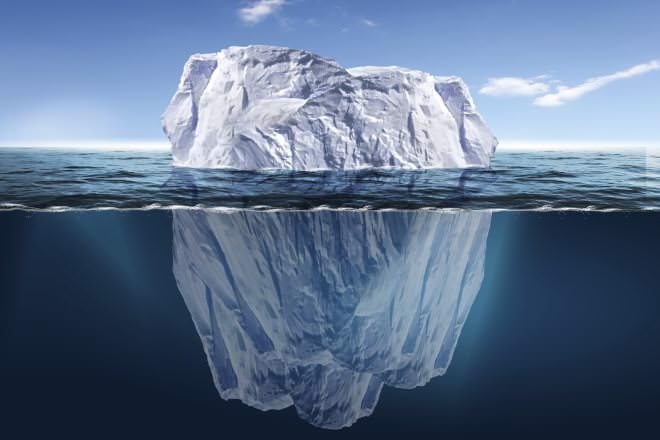An iceberg is a big chunk of ice broken off from glaciers. The process of breaking off from the bigger glacier is called calving. These are floating in the ocean but are made of frozen freshwater. These are not made of saltwater.
The Northern Hemisphere has more icebergs and they are broken off from Greenland. Many times they drift into waters using the current and remain afloat for long duration. In the Southern hemisphere icebergs are formed off the glaciers of Antarctica.

Size of Icebergs:
Many icebergs are small:
- Bergy bits are floating sea ice that measure not more than 5 meters or 16.5 feet above the ocean.
- Growlers are even smaller in size.
The bigger icebergs are situated closer to Canada. The iceberg that hit the Titanic was also considered to be huge. Near Antarctica a few icebergs are as big as Sicily which is the largest island of the Mediterranean.
As little as one-eighth of an iceberg is visible above the water. Most of the mass of an iceberg lies below the surface of the water.
Reason of formation of an iceberg:
The iceberg breaks off from the glacier for two reasons:
The glacier moves to a forward downward sloping area and the end of the glacier breaks off from it and falls into water.
The second reason is warm water or air. The glacier warms and a lake is formed in the middle of the glacier by carving a depression and the rest of the ends fall off due to gravity forming an iceberg.

The second reason listed above may be due to global warming.
These icebergs are freshwater sources. Almost 90% of icebergs are underwater due to the mass of water it carries.
Types of Icebergs:
Brash ice- It is a collection of floating ice and icebergs that measure not more than 2 meters or 6.5 feet across.
Tabular berg- It is a flat-topped iceberg formed when ice breaks directly off an ice sheet or ice shelf.
The icebergs are dangerous to ships as the complete mass is not visible from the top. Moreover they have sharp edges which may cut through the material of the ships causing them to sink. This is how the Titanic sank. A part of the North Atlantic is specially called Iceberg Alley because of the amount of icebergs that are there.
Comments
All Comments (0)
Join the conversation